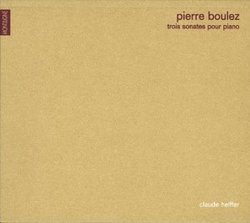| All Artists: Boulez, Helffer Title: 3 Piano Sonatas Members Wishing: 0 Total Copies: 0 Label: Disques Montaigne Release Date: 9/12/2000 Album Type: Import, Original recording reissued Genre: Classical Styles: Chamber Music, Forms & Genres, Sonatas, Historical Periods, Classical (c.1770-1830), Modern, 20th, & 21st Century Number of Discs: 1 SwapaCD Credits: 1 UPC: 713746169022 |
Search - Boulez, Helffer :: 3 Piano Sonatas
 | Boulez, Helffer 3 Piano Sonatas Genre: Classical
|
Larger Image |
CD Details |
CD ReviewsOnly Second Best John Atwell | Canoga Park, CA USA | 01/05/2001 (2 out of 5 stars) "Helffer is trying to make these masterworks his own - but at the expense of clarity. Boulez needs clarity of performance, otherwise these piano pieces could be written by anybody. Helffer rushes almost all the time. Sometimes his fingers are moving so fast that the notes literally don't speak. A good example is the 2nd Sonata, 2nd movement. In this slow movement, there is a frank passage of 4 against 3. Helffer can't really delineate this rhythm - compare this with the excellent Pollini reading, where this simple rhythm is fashioned into an apotheosis.Add to that (what seem to be) a few bad digital edits, and this disc is definitely second place. I don't know any better recording of the 1st or 3rd Sonatas, but Maurizio Pollini's 2nd Sonata is still the most breathtaking Boulez performance by a soloist." Some problematics in conceptual trajectories = = = scarecrow | Chicago, Illinois United States | 04/14/2006 (5 out of 5 stars) "The First Sonata needs to find a conceptual place between its alternating lifeworlds of simplicity and brutality, the opening six ideas of the ringing sustained F# and D F to Eb, then the downward arpeggio,rapide in 32nd notes. Helffer is excellent. His interpretation must grow on you a bit. I initially thought as well all this speed served no function. You doiwant mystery in Boulez and multiplicities of momentum. Helffer instead gives us electrified timbres, with many times no discerable shapes.The balzing/blazing speed doesn't overdetermine,/predetermine the First as it would in the more sprawling bottle neck-violences of the Second Sonata.
I disagree on the merits of Pollini's reading of the Second Sonata. Pollini's Second is too cold and phanthom like, it produces clarity,yet no vision and little else, it doesn't move beyond the works uncompromising constitution,His Schoenberg is another story however.Perhaps the narrative there is more self-evident,more surface oriented. For Boulez it is Yvonne Loriod. I prefer her, she came to understand the young Pierre deeply, touring with him even with his first book of 'structures', and the Yvonne's scope of the Second as enraged with a seeming endless resonance is remarkable,her rhytmic momentums she builds and dissaptes is also inspiring on the Second; if you can find it, it on an old Vega Vinyl. Helffer ascends more to the indeterminate opulent elegant Third Sonata as Psi-Chen. This, the Third is now a completely different Boulez, with the path-breaking "Le Marteau sans Maitre" and the "structures" for two pianos under his experience as a composer.So the Third exploits more an indeterminate path,with greater arrays and layers of timbre, use of all the piano's pedals, articulation schemes, and opposing tropes of the sustained timbre to the arpeggiated ones. Marilyn Nonken also understands the Third, but Alas! no recordings only LIVE, In some respects you can clearly understand Helffer's penchant for pushing the speed in all these works in an irrational way, hurling fine exquisite lines, where the linear pitch logic comes to be reduced to its lowest common denominator.It pays quite little in interest in the Second, where the energized propelling motivics cells come to resemble simply mishapened noises. So the work is simply effect/affect. I think all these Sonatas work best with a sense of rhythmic freedom (within reason)something Boulez has/had cultivated his entire career.(Conducting Mahler for example, he finds where the freedom parts of the phrase exist in relation to the overall tempi, in"envelope" spaces) Yet the Loriod is truly indelible, you never forget it, yet Pollini is already forgotten, no impression Maurizio.Helffer has the courage to follow excitement." |

 Track Listings (8) - Disc #1
Track Listings (8) - Disc #1